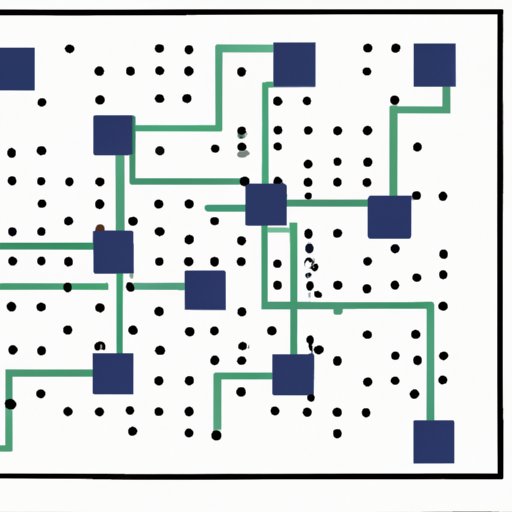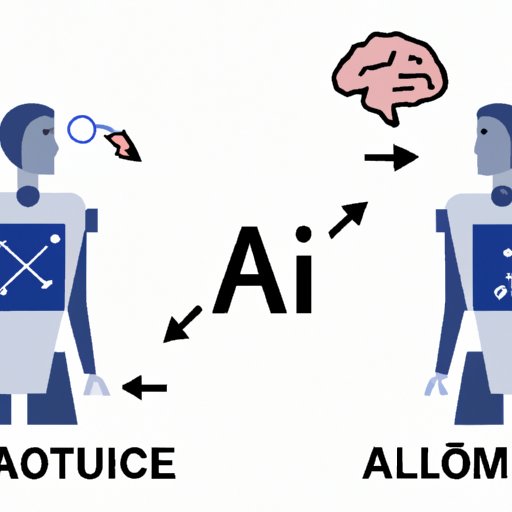An Overview of Algorithms in Computer Science
Algorithms are fundamental components of computer science that enable the automation of data processing and problem solving. They are a set of instructions or steps that can be followed to achieve a desired result or goal. Algorithms are used widely in computing and have become increasingly important with the rise of artificial intelligence (AI). In this article, we will explore the different types of algorithms, their role in computing, and their impact on data processing.

Explaining the Different Types of Algorithms
Algorithms can be broadly classified into five main categories: search algorithms, sorting algorithms, graph algorithms, network flow algorithms, and randomized algorithms. Each of these categories has its own unique features and applications.
Search Algorithms
Search algorithms are used to find specific items within a data set. Examples include linear search, binary search, and depth-first search. These algorithms are used to quickly locate desired information within large datasets.
Sorting Algorithms
Sorting algorithms are used to organize data into a certain order. Examples include bubble sort, insertion sort, and selection sort. These algorithms are used to efficiently sort large datasets.
Graph Algorithms
Graph algorithms are used to analyze relationships between data points. Examples include shortest path algorithms, minimum spanning tree algorithms, and maximum flow algorithms. These algorithms are used to identify patterns and solve optimization problems.
Network Flow Algorithms
Network flow algorithms are used to model the flow of data through a network. Examples include Ford-Fulkerson algorithm, Edmonds-Karp algorithm, and Dinic’s algorithm. These algorithms are used to optimize network traffic and design efficient communication networks.
Randomized Algorithms
Randomized algorithms are used to generate random numbers or patterns. Examples include Monte Carlo algorithms and random walk algorithms. These algorithms are used to simulate real-world events and generate unpredictable results.
String Matching Algorithms
String matching algorithms are used to compare two strings and determine if they are similar. Examples include Boyer-Moore algorithm and Knuth-Morris-Pratt algorithm. These algorithms are used to detect plagiarism, locate patterns in text, and recognize handwriting.
Examining the Role of Algorithms in Computing
Algorithms are essential tools for solving complex problems. By breaking down a problem into smaller steps, algorithms can help simplify and speed up the process of finding solutions. Algorithms can also be used to identify patterns in data and automate repetitive tasks.
How Algorithms Help Solve Problems
Algorithms provide a step-by-step approach to problem-solving which makes it easier to understand and execute complex tasks. According to research from Stanford University, “Algorithms allow computers to quickly solve problems by breaking them down into simpler steps. This simplification of problems can reduce the time required to solve them, making algorithms invaluable tools in computing.”
Advantages of Using Algorithms
Algorithms offer several advantages over traditional methods of problem solving. They can be used to solve problems much faster than manual methods and can be applied to large datasets with ease. Additionally, algorithms are less prone to human error and can be used to automate tedious tasks.
Examples of How Algorithms Are Used
Algorithms are used in many different fields, including machine learning, natural language processing, robotics, and computer vision. For example, machine learning algorithms are used to classify images, while natural language processing algorithms are used to process text. Algorithms are also used in search engines, such as Google’s PageRank algorithm, and social media platforms, such as Facebook’s News Feed algorithm.
Analyzing the Impact of Algorithms on Data Processing
Algorithms have revolutionized the way data is processed. By automating data processing tasks, algorithms can significantly reduce the amount of time it takes to perform complex tasks. This can have a major impact on businesses, allowing them to quickly respond to changing market conditions and customer needs.
Automation of Data Processing
Algorithms can be used to automate data processing tasks, such as sorting, filtering, and summarizing data. This can reduce the amount of time it takes to process large datasets and make data analysis more efficient. According to a study by the University of California, “Algorithms can automate data processing tasks, allowing organizations to quickly analyze large datasets and make decisions based on the results.”
Benefits of Faster Data Processing
Faster data processing can lead to better decision making and improved customer service. By using algorithms to automate data processing tasks, businesses can quickly respond to customer needs and identify new opportunities. Additionally, algorithms can be used to detect fraud and improve security.
Challenges Posed by Algorithms
While algorithms can provide many benefits, they can also pose challenges. Algorithms can introduce bias into decision making processes and lead to unintended consequences. Additionally, algorithms can be difficult to debug and maintain, leading to errors and delays in data processing.

Investigating the Benefits and Limitations of Algorithms
Algorithms can be incredibly powerful tools for solving complex problems, but they also have their limitations. It is important to understand both the benefits and limitations of algorithms in order to use them effectively.
Efficiency and Optimality of Algorithms
Algorithms can be designed to be more efficient and optimal. By optimizing the steps involved in an algorithm, it can be made to run faster and use fewer resources. Additionally, algorithms can be designed to produce the most optimal solution to a given problem.
Pros and Cons of Algorithms
Algorithms can provide many benefits, such as faster problem solving and automated data processing. However, they also have their drawbacks, such as introducing bias and complexity. It is important to consider both the pros and cons of algorithms before using them.
Trade-Offs Between Speed and Accuracy
When designing algorithms, there is often a trade-off between speed and accuracy. Algorithms can be optimized to run faster, but this may come at the expense of accuracy. It is important to consider the trade-offs between speed and accuracy when designing algorithms.

Evaluating the Usefulness of Algorithms in Artificial Intelligence
Algorithms play an important role in artificial intelligence (AI) and are used extensively in machine learning applications. Algorithms can be used to identify patterns in data, automate decision making processes, and optimize solutions to complex problems.
Applications of Algorithms in AI
Algorithms are used in many different applications of AI, such as image recognition, natural language processing, and robotics. For example, algorithms can be used to identify objects in images, process text, and control robots. Algorithms are also used in self-driving cars, facial recognition systems, and recommendation systems.
Challenges of Using Algorithms in AI
Algorithms can be difficult to design and implement in AI applications. Additionally, algorithms can be prone to error and require significant resources to run. It is important to consider the challenges of using algorithms in AI before implementing them in a system.
Benefits of Using Algorithms in AI
Despite the challenges, algorithms can provide many benefits in AI applications. Algorithms can be used to automate decision making processes and optimize solutions to complex problems. Additionally, algorithms can be used to identify patterns in data and improve the accuracy of predictions.
(Note: Is this article not meeting your expectations? Do you have knowledge or insights to share? Unlock new opportunities and expand your reach by joining our authors team. Click Registration to join us and share your expertise with our readers.)
